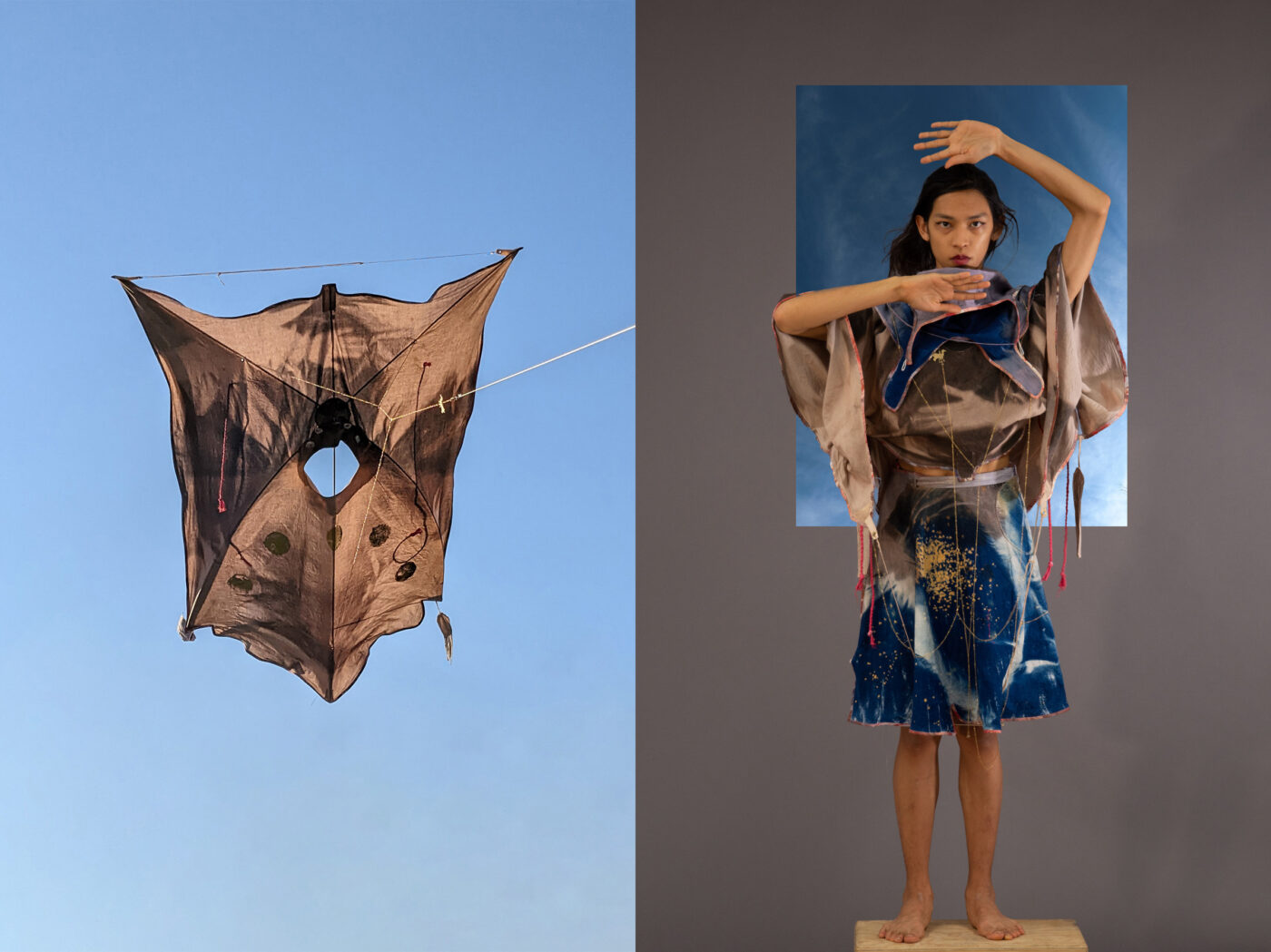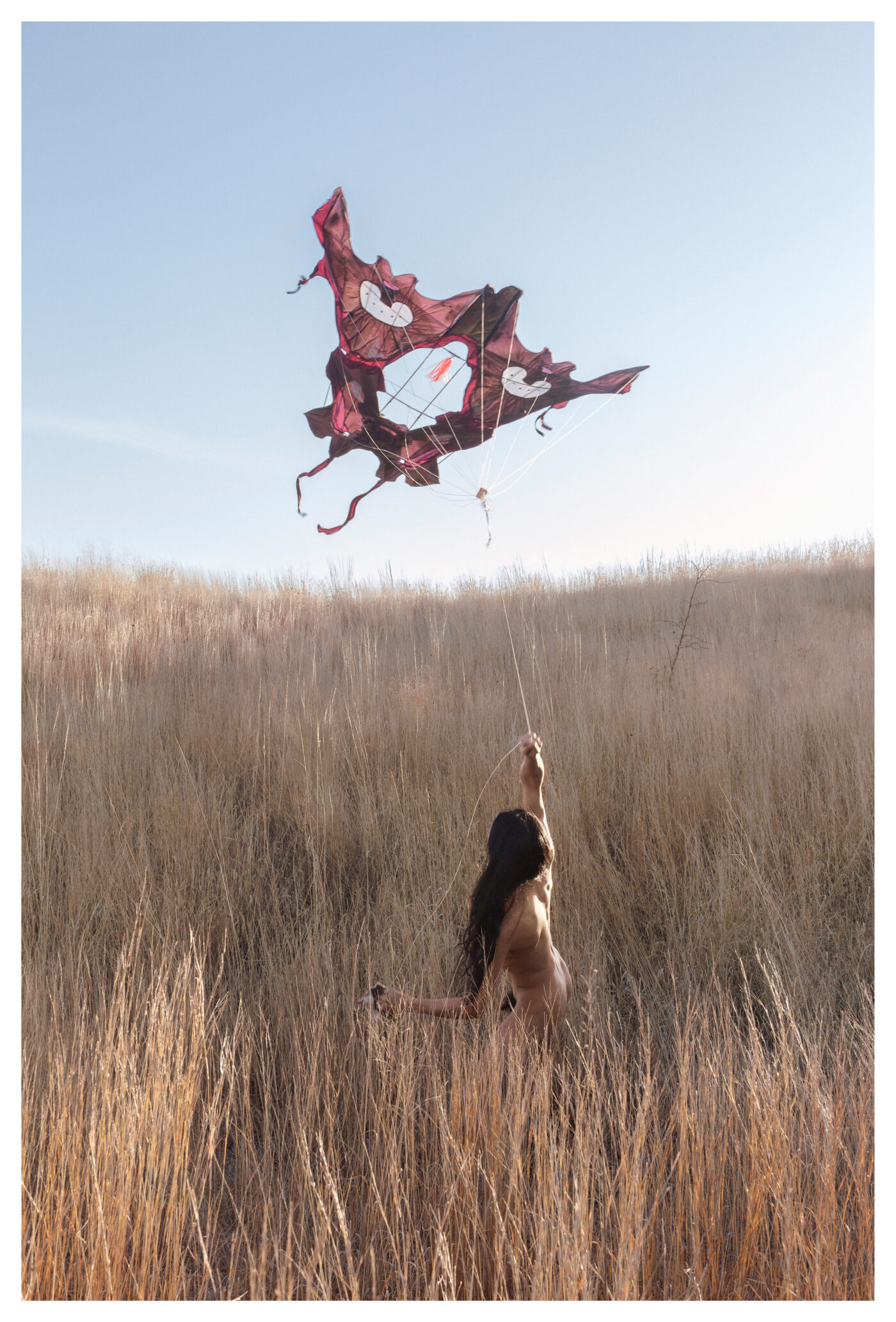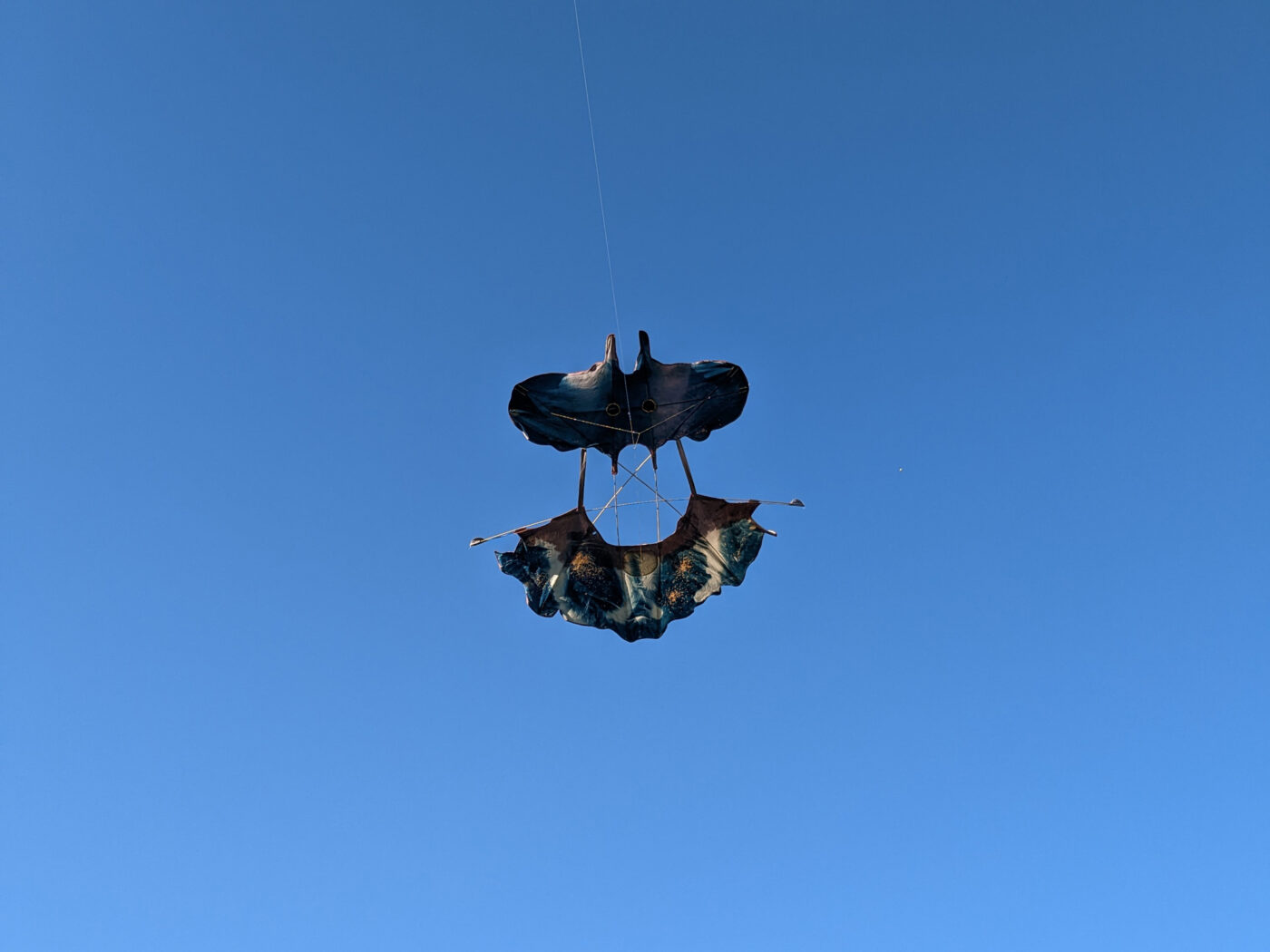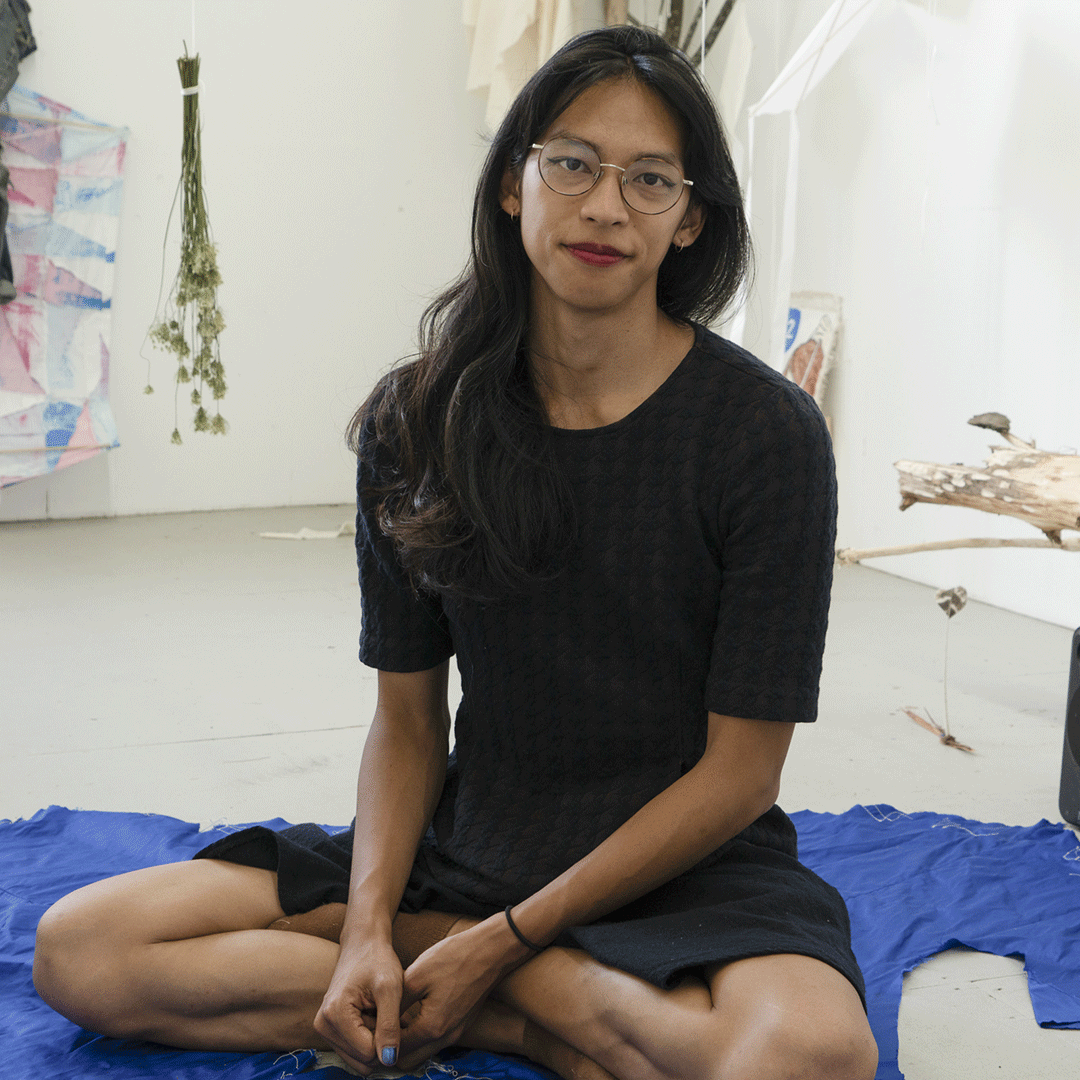

“There is nothing new under the sun, but there are new suns.” –Octavia Butler

4-5 minute read, or the time it takes to water some flowers.
The sky above us never stops inspiring awe. At night, the Milky Way’s patterns echo ancient myths. By day, man-made trails cross the blue expanse. Yet the simple joy of watching a kite dance in the wind, mingling with the clouds, reminds us that a kite doesn’t take the path of least resistance. It is also free from those burdensome thoughts. In Hai-Wen Lin’s piece Redressing the Sky, one senses how the act and embodiment of flying a kite can repurpose an entire notion of what fashioning can entail, leaving infinite paths open for the diasporic adventures design could embark on.
BY HAI-WEN LIN
It’s often been said that to change the world you must change yourself, and more often than not, we go through our closets and change at least once a day. We are wary of how the world sees us. We are wary not just of the eyes of other humans, but how intently the sun might stare, the glimpse of rain, or if the wind will glance our way.

[ID: A collage of two photos showing the dual function of the artwork, a garment-kite. Left: a six-pointed kite of hand-dyed fabric flies in a bright blue sky. Right: the artist stands on a wooden platform wearing the kite as a garment, its strings completely transformed into ornament, in front of a similarly-hued blue sky backdrop in a gray portrait studio.]
In her piece “Lecture on the History of Skywriting,” Anne Carson asks, “Is the sky something or merely what is left over because everything else has edges?” You can tell when someone has studied fashion because we have a habit of flipping the edges of every garment. Consider a rolled hem, a French seam, or a lace finish; resolving the edge is one of the primary concerns of fashion design. Fashion is the construction of how one meets the world.
In my practice, I make and fly kites, using the language of garment construction such that the wind and I can take turns exchanging clothing. I see clothing as the threshold between ourselves and the environment and consider what it might mean to extend and open that boundary, displacing it off of skin, blurring the relationships of interiority and exteriority, to free, fly, and extend the body.

[ID: Photo of the artist standing clothless in a field of waist-high prairie grass, holding a garment-kite aloft in the wind. Its dyed-pink-red-brown fabric wings are mothlike, symmetrically patterned with amorphous cutouts and held together with multiple rods and a web of white string.]
I begin with patternmaking, an act of taking measure and making space. How does a structure fit a torso, an arm, or a neck? And can we make space for the sky? Dressing is an incredibly intimate task of deep care. I think of the ways we swaddle a child, or help an elderly parent. Perhaps my work is a simple attempt at acknowledgement. The wind carries heat, moisture, and plants in silent labor. Can we take notice of that which is invisibilized in our world and offer it a coat?
When I first understood myself to be nonbinary, my body felt untethered and fashion offered a way of constructing new versions of myself and a sense of bodily autonomy. Maybe dressing the wind is not so different. If fashion pedagogy begins with reading a body to collect bust, waist, hip, neck, armscye, inseam, then to map the nonbinary is to measure and make space for illegibility. I admire Rei Kawakubo’s uneven asymmetrical garments in this regard. As Erin Manning writes in The Minor Gesture, “Fashion for [Kawakubo] is not limited to the idea of a holding-in-place of a body as pre-formed.” This is clothing not simply sewn to fit a model’s body, but clothing that takes an active role in producing and constructing new spaces and new bodies.

[ID: Photo of the underside of a garment-kite flying in a bright blue sky.]
So the shaping and making of clothes for the wind and sky plays an active role in redefining where and how the sky exists, producing and binding new edges. Measuring the sky — the first written account of the kite was in its use to measure — can become analogous to some indigenous forms of countermapping, drawing lines and building paths to visions of the world both pre- and post-colonial. Taking measure allows us to right a wrong. It allows us to offer redress.
The gambit of capitalism is that we live in a scarce world, but is that not easily disproved by looking at the vast expanse above us? Clouds exist fractally; every piece contains the whole at every scale. If we cut patterns from the sky, we lose nothing.
Ultimately, fashion is a medium of desire, of how we wish to be seen. But we should remember that dressing ourselves is also a practice of how we see the world and the worlds we hope to inhabit. To put our true selves forth is not too dissimilar from flying a kite. It is the casting of a wish, a gesture towards a liberatory future, while standing in the present. Sometimes I fly my kites wondering what it may be like to be soaring, up in that world of wishes. Then I strip my clothes and change.

[ID: A person smiles softly while seated cross-legged on top of an ultramarine cloth. They have long, dark wavy hair, tan skin, and are wearing round wire glasses, red lipstick, and a dark shirt and shorts. ]
Hai-Wen Lin is an artist based somewhere between the earth and sky. Their practice explores constructions of the body and the redressing of the environment. Materials often include metaphors, etymologies, sunlight, wind, and the way time passes perfectly when you are out walking on a beautiful day. Lin is an alumnus of the Skowhegan School of Painting and Sculpture and earned a Master of Design in Fashion, Body, and Garment from the School of the Art Institute of Chicago. They are one of the American Craft Council’s 2024 Emerging Artists, a 2023 CFDA Fashion Future Graduate, and are a recipient of the Hopper Prize and fellowships from MacDowell, Vermont Studio Center, and the Ox-Bow School of Art. Lin is a former resident of the Houston Center for Contemporary Craft, Haystack Mountain School of Crafts, and Wassaic Project. Lin has performed publicly at the Chicago Cultural Center and MU Gallery and exhibited work at Prairie; the Chinese American Museum of Chicago; the San Jose Museum of Quilts and Textiles; the Pittsburgh Glass Center; the Czong Institute for Contemporary Art; the walls of their home; their friend’s home; on a plate; on a lake; on their body; in the sky.
haiwenlin.com
Instagram: @hai_wen_lin
